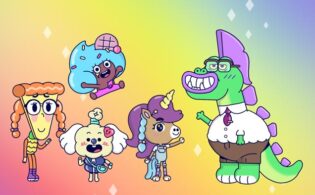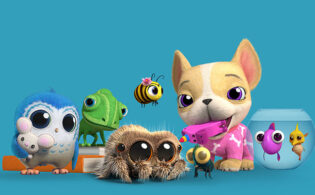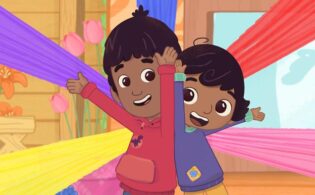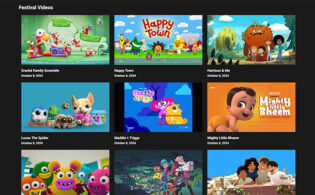Ed Galton and Dominic Gardiner have known each other for years, as they are both longtime executives in the children’s content business. The underlying respect and friendship helped move along negotiations when Galton, CEO of CAKE, approached Gardiner about buying Jetpack Distribution. The acquisition was completed in September, with CAKE doubling the size of its library to 3,200 half-hours and Gardiner joining the company as managing director of distribution. TV Kids speaks with both executives about the deal, as well as the state of the industry and its challenges and opportunities.
TV KIDS: How do you see the kids’ business right now? I hear there’s a lot of caution and risk aversion.
GALTON: The market is very skittish at the moment. The U.S. market has not settled down yet. There’s uncertainty at Paramount until the Skydance deal goes through and they figure out what that business is going to look like. There is major uncertainty at Warner Bros. Discovery. They do not seem to be focusing on Cartoon Network, which has impacted both our business and many others. As for the streamers, a lot of us experienced a really good moment for five years because they were land-grabbing and trying to beef up their platforms as much as possible. Now that the business has matured and there’s more market intel, they’re pulling back and seeing what’s inefficient. We’re suffering the impact of that as well. That starts in the U.S. but also trickles down to what’s happening in other parts of the world. Also, specific to the kids’ business, there’s certainly been a movement away from linear television in the last five to ten years. It’s reached a point now where it is so evident that kids spend time in multiple ways engaging with content on platforms outside of the TV space. Therefore, the business that we have done very well in over the years has now shifted.
TV KIDS: How does a company like CAKE navigate this landscape?
GARDINER: The combined catalogs of CAKE and Jetpack mean that we have more opportunities to sell our content to a myriad of platforms and outlets. We’re building on the linear business, the VOD business, and YouTube is a priority through our digital arm, Popcorn Digital, which we’ve expanded with Matt Lieberman helming the business out of Los Angeles. The strategy is to make sure that we are on all the platforms and devices where kids are, not only by making sure that we license content but also by looking at those platforms for inspiration, developing new content and taking it from YouTube and placing it elsewhere. We’re in the kids’ business. We’ve got to keep up with the kids. They’re always on the move. Being more resilient and nimble is what will give us success in the future.
GALTON: The AVOD market will mature, and I firmly believe it will be a significant revenue stream for our business and others moving forward. You’re already seeing it with open platforms like Tubi, Roku and Pluto TV, which are really gaining a lot of traction in the U.S. There is still a business with advertiser-supported platforms. It’s not all about subscription. But for that to make sense for us, we need to have a certain scale and volume of content to support this growing market.
TV KIDS: How did the Jetpack deal come about?
GARDINER: Ed and I started talking a couple of years ago. CAKE was interested in growing, and Ed came to me and said, We’re looking at an acquisition strategy. At Jetpack, we had grown steadily over eight years. We came out of the pandemic in good shape. But in 2022, we could see that the market was going to enter some choppy waters. We probably weren’t going to hit growth targets on our own, and the longer term was very uncertain. So, joining up with CAKE would provide us with security. We totally agreed with CAKE’s strategy and decided that we should keep talking and find a deal, which we eventually did.
TV KIDS: What are the advantages for CAKE?
GALTON: Scale is important. Having Dom on the team is great; he has a ton of experience! And together, we’ve been in the kid-specific business for a long time. But Dom brings a different perspective than we’ve had because he worked on the channel side of the business. We’ve never had someone with that level of experience work inside our house, and it’s advantageous to have that intelligence. As you get to know Dom, you understand that he’s very inquisitive and asks a ton of questions! And I learned over the years that he does that because he’s trying to get information from you.
It’s good to have someone on the team with that sense of curiosity and the urge for intelligence gathering. We also brought Toby Jones across as senior sales manager. What was really interesting when we did the data mining was that we learned that while CAKE and Jetpack were both in the kids’ business, we had very different clients. So, that meant that we were now adopting an entirely new client base that we didn’t have before. Plus, we’re picking up a catalog of some great shows like Dennis and Gnasher: Unleashed!, Clangers, Mechamato and Talking Tom & Friends. The buzz we saw during Brand Licensing Europe (BLE) around Talking Tom was quite impressive. So, we’re excited.
TV KIDS: Given the market, what are buyers and commissioners looking for? Is it still known IP that offers that comfort zone, or do originals have a chance?
GALTON: It depends on who you talk to. We’re seeing a lot of businesses taking on known brands, as they have established awareness and a built-in fan base. That gives them a kind of instant marketing. The streamers have been challenged on how to market content directed at kids. Discoverability is still challenging in a world where kids choose content based on tiles and artwork.
GARDINER: Yes, the discovery issue is nothing new. It’s just that the solutions that we used to use, whether promos, advertising, outdoor, bus sides, those marketing spends have been under a lot of pressure as money is tight. So, building something new is taking longer, and it takes a lot more patience. The expectation of the market is still to launch a show within three weeks, whether it’s a hit or not. That doesn’t exist anymore; you’re talking 12 months of hard work to build shows.
A lot of the new platforms came to this business with some knowledge and expertise but not the full breadth of knowledge of people in linear TV, who have been doing it forever. I think, slowly, they’re learning how to promote and position content, reflect on the research and the numbers and understand their audiences better. We’re seeing a shift, and I’m encouraged by those UI developments because the platforms are learning. That could be beneficial because we know that some of the shows that are presented to us and that we’re working on are amazing shows. And they’ll be just as good as something that’s familiar or a household name. We believe in them. We just need to convince the marketers and the broadcast platforms that they will reach the audience.
GALTON: What we hear is, We need a known brand, but we’re also looking for the next Bluey. You can’t talk out of both sides of your mouth because it just doesn’t make any sense. I am not a platform designer. I’ve never managed UIs. However, it is obvious that kids consume content differently than adults, and these UIs that were built for the streaming services were probably never built with kids in mind. Kids were the afterthought. That needs to be corrected and adjusted, and I think they’ll figure it out over time. You can say kids are not really important for so many streaming services because they don’t grow the subscriber base. But then, you look at the data and what does that say? Bluey was the most streamed series in the U.S. this summer. How many shows targeted to the 18-plus demographic are $2 billion brands? If you do it right, there’s potentially more value in the kids’ business than in other genres.
TV KIDS: Would you give some examples of how you expose a property to make sure kids can sample it and then build a brand?
GALTON: Originally, it was not our job to do that. We would provide content to platforms and broadcasters, and it was their job to get their audiences to watch. Over the years, that’s changed quite a bit. There’s been a reliance on content creators to help market shows. You’ve seen YouTube playing a really big role, having built significant brand value on the platform and seeing it cross over to linear. There’s an example of your built-in marketing. It’s clear we have to work a lot harder as content creators and providers to third parties to help make those shows have more awareness for the consumer.
GARDINER: There’s got to be much more collaboration at an earlier stage in development. It used to be a very linear process, from development to production to broadcasting. Whereas now, the involvement of licensors, toy companies, publishers and even podcasting—what we used to call the ancillary businesses that would follow the broadcast at some point in the future—want to join up much earlier. Ed mentioned BLE. There is an amazing range of touchpoints with the audience: the toys, apparel, plush, etc. Those companies and brands want to be involved in the process earlier. Of course, there are some leaders in that space. It’s not brand new. But now that there’s a more mass-market approach, I think that will really help. It’s not a relay race where you’re waiting for one guy to finish before you can start. We’re all working at the same pace, which helps a show get greenlit and is much welcomed.
TV KIDS: Are you seeing financing models changing? Do you almost always need a partner to get something off the ground?
GALTON: The short answer is yes. We don’t have the purse to self-finance series. In our game, it’s too expensive. The financing model is definitely changing, and we have to find smart ways to put shows together. Our USP has always been the fact that we were good at that. People would come to us asking, Can you help us figure out how to put the puzzle together? I remember before the Netflixes of the world; we always had to string money together to get the show fully financed. Then, in the last five years, streamers started to finance the entire budget, and we followed that model too. I wouldn’t say we’re reverting back to what we used to do before because it certainly has changed, and we’re not reliant on the old-fashioned European co-production model. We have always worked with various organizations around the world that can help finance projects, whether government-backed or private equity-backed, etc. We’ve worked on those types of projects and we’ll continue to do that. As an example, we brought in Crayola Studios on Pablo: Boy Meets School, which has meant the series commissioned by BBC Children’s and RTÉjr is now able to go into production.
TV KIDS: Looking ahead, is next year still going to be marked by caution? Is the business still working through problems, or is there light at the end of the tunnel?
GALTON: I think it’ll be a combination of all three. There are too many smart people doing what we’re doing who will find a path and figure some of this out. Some of the traditional clients that we’ve worked with will change and go away, for sure. Some companies that we did a lot of business with will not be there anymore. Some of the larger platforms, hopefully one, maybe two, will figure out that it makes sense to dive in and really stay in the kids’ business. That will be helpful to our business. But it’s also about taking advantage of a down market. For some of the bigger platforms that have their own studios, that have to finance their own content and that are not getting the resources to do that, we can provide a solution because the platforms still need content, and we believe we can do it for less money and more efficiently, as long as we have the right strategies.
GARDINER: And we do have the right strategies!
 TVKIDS
TVKIDS






